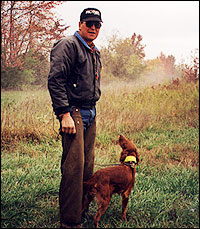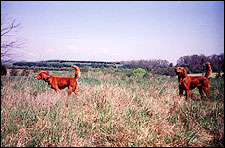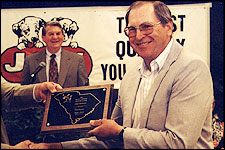They are said to be not as soft as other setters but not as hard-headed either. For whatever reason, the red setter is making its mark with birddog fans.
By Nick Sisley
The color of a setter is. . .Red
There's been a great deal of controversy around that subject for many decades. Interestingly, breeders of the 1800s apparently were not so concerned about setter color, or at least color ended up being a relatively minor consideration when matings were contemplated. Irish setters were mated with black and brown Gordon setters. Both were mated with English setters. Other than color, all three tended to possess similar confirmation characteristics back then. When all three colors of setters were first imported into this country during the latter part of the nineteenth century, this philosophy of breeding continued to prevail. The best setters were often bred together--with little thought given to color.
Somewhere along the line this philosophy changed. Interestingly, this old setter philosophy seems to continue with Labrador retrievers. While black predominates, probably because that's the dominant gene, any Lab litter can have yellows or chocolates. If breeders would cull out all yellow and chocolate pups it probably wouldn't take many generations before all Labs would be born black. Lab breeders and Lab dog registries have taken the casual approach with color. But because we have Irish setters registered separately from Gordon setters and English setters, color has long been an issue.
For whatever reason, English setters were (still are) predominantly registered with the Field Dog Stud Book (FDSB), while Irish and Gordon setters were predominantly registered with the American Kennel Club (AKC). While the AKC does have field trials for their pointing breeds, FDSB trials are definitely more for dogs that can really ramble, resulting in a genuine show of their physical prowess. The AKC also has continually placed heavy emphasis on show qualities. With its magnificent red coat, the Irish setter certainly became a crowd pleaser in the show ring. While I have nothing against that, there's no question that these dogs suffer, after generations of breeding, in most all the qualities a shooter wants in a pointing dog.
Thus was the plight of the Irish setter. Through the first half of the twentieth century this breed's hunting qualities deteriorated. A dog writer of great experience, Horace Lytle, brought this to public attention in his Field & Stream magazine dog column in 1946, suggesting that the Irish setter needed some influx of rich English setter blood if they were going to make any comeback as pointing dogs in the hunting field. There was a great uproar over this. In fact, Lytle was gone from the pages of this famous magazine a very short time later. Did he lose his job because of his views on this subject? Some claim this is so.
But Lytle had laid down the gauntlet. Ned Le Grande picked up that glove. So did others. The FDSB agreed to register these dogs, as Red Irish Setters, but only after at least so many generations had been bred. During this period meticulous records had to be kept and submitted to the FDSB until the genes were fixed and these new red setters would breed true to form.
 Ready at the breakaway. |
I won't go into those early crosses with English setters, other than to say English setter Mississippi Zev's progeny were involved. Later, perhaps Johnny Crockett's progeny got into the act. Both were National Champions at Grand Junction, Tennessee. Let's fast-forward several decades--to a then veterinarian--Roger Boser. He received his first red setter at age 16. Got his second while still in college. He campaigned dogs actively while he was still working as a vet, but he retired from practice in 1988 to devote full time to his red dogs. He has been phenomenally successful--with more than 1000 placements in field trials.
A young dog out of his many time winner, Desperado, has just won the Red Setter National Championship held in Berea, Kentucky. That new champ, Kiski's Big Red, is owned and was handled by a close friend of mine, Harry Rollinson. He lives just down the road from me. But before I get into talking about Harry, his dog and covering a bit of that trial, back to Roger Boser.
Desperado has 120 field trial placements. Roger claims he would have won more, except that he was almost always competing with his sire, Bearcat. This Boser red dog has more field trial placements than any in history--158. So there's little wonder that Bearcat knocked Desperado out of placement at more than a few trials. Boser gives Le Grande credit--for supplying the "foundation" dogs of his kennel. He went on to tell me that because the gene pool of red Irish setters is relatively small, most of these dogs that are winning field trials now owe just about everything to the Ned Le Grange pool of genes.
About three years ago Harry Rollinson began telling me about how great Boser's red dogs were. He was encouraging me to get one for myself. I travel to hunt out of state every year, but I also hunt ruffed grouse every day of the Pennsylvania season. So my dogs get more than their share of hunting time. I guess I wasn't listening to Harry when he figured I probably needed a replacement. Rollinson went on to say that he bought a red setter from Boser, ". . .because I got tired having his dogs beat mine every weekend!" Harry has run English setters and pointers most all of his bird-dog life. Even today he has one English setter and six pointers in his kennel--to go along with Kiski's Big Red (called Jack). During the spring of 2002 Harry placed four different dogs in field trials, so his expertise is not only with red setters.
Harry's wife, Linda, though not currently a handler, is heavily involved with Harry's dogs and field trailing. I asked them both what standout qualities these red setters from Roger Boser had. Harry opened with how easy these dogs are to train. While some English setters might be a little soft (thus might not take to early training all that eagerly) and pointers sometimes tend toward being a bit head strong, these Boser setters don't lean toward either of these characteristics.
 Beonat pointing, Desperado backing. |
Rollinson went on to say that he felt these red dogs would be especially well suited to a trainer with minimal experience, as well as a person who was only going to shoot over one or two dogs. The inference in the first place
was that these dogs are just pretty good at training themselves. The inference in his second point was that these dogs simply thrive on a lot of attention.
One of Harry's favorite red-setter characteristics, especially where his Jack is concerned, is that there's no loss of composure during and after the flush. The high degree of intensity remains, as well as the rigid stature and poker straight tail. Jack is also a very fast dog at the breakaway. His ground pattern is very big. Of course, Harry has encouraged this in his training, a lot of it from horseback. But Jack is also a house dog, and I can attest that his personality is very laid back--just lies down without being told--usually eyeing Harry the whole time. On a tie-out stake he's barking and in constant motion, perhaps indicating his desire to be turned loose so he can show his mettle in competition. There was nothing to house-breaking Jack. When he wanted to "go" he'd walk to the door and so indicate. Not one "accident" indoors--ever.
In 2001 Harry took Runner Up in the Red Setter Futurity with Jack, so this is still a very young red setter. The trial grounds for the futurity were/are the same as for the Red Setter National Championship--the Central Kentucky Wildlife Management Area near Berea, Kentucky. The Championship involves one-hour heats--over three different courses. To be eligible entrants must have a place in either a derby, open all-age or shooting dog stake. Local field trial clubs augment the native bird supply by adding quite a number of quail each spring and fall but well prior to any field trials. No birds are released the day of the event, as is done at many field trials.
Judges Buzz Miller and Gary Jones gave the signal to, "Cut 'em lose." The 2002 Championship was underway. Harry's Jack was in the first brace, with Stan Zdanczewicz's Peabo, the red setter that was the l 995 winner of this event, the Runner Up in 2001. Harry didn't know the courses very well, having only been to these grounds the previous year for the futurity.
Harry didn't see Jack shortly after the breakaway for about five minutes. At the first crossing Harry saw a dog standing. Someone, maybe from the gallery, had called to Stan Zdanczewicz that his dog was on point. But it was Jack, with the green collar, on point, not Peabo, who wore a red one. Rollinson dismounted, walked in and flushed. A good covey got up, then, as he was walking back to his still-steady Jack, two woodcock flushed from close by. Bonus birds? Next they rode into a huge open area, with a natural woods edge on the right. Jack ringed it all. "After that first find he was really fired up and running," is the way Harry put it. But Harry wasn't sure which way the course went, so he was worried his dog might get off course a bit. But every so often his red setter would show briefly in front. Rollinson took another edge, looking for the dog, got a bit ahead of the judges and soon saw him on point again. The judges were called up. Covey number two was soon figuratively in Harry's hip pocket.
By this time, Stan and Peabo were well ahead, so Harry heeled Jack toward the front. His dog showed well for about 10 minutes, but then they lost sight of him. Roger Boser was scouting for Harry. Boser went left of the course, Harry continuing to the front, both the men looking. Harry found Jack on point for the third time, in heavy cover, right at the far end of the edge the dog had been working. He flushed the covey from about 15 yards in front. Now there were maybe 15 minutes to go. Peabo had had one find, but Harry had not been there to see it.
My friend tried to lead his dog to the area where he had found a covey during the previous year's futurity but without luck. This is when Jack angled a bit left of the course. Harry was again anxious about which direction the course took. Roger Boser told him where the course was, then rode off to find the dog. Boser found him, then got Jack started back in the right direction. It was an anxious time for Harry (fearing he would lose his dog so near the end) because he felt three huge covey finds were putting Jack in awfully good stead, plus his race had been such a big one. But with about five minutes to go Harry had him showing in front, Jack running with a classic, hard finish. Then it was time to "Pick 'em up."
 Receiving an award. |
There were 11 more braces to run over the rest of that March day and the next, and Harry Rollinson had to wait, nervous stomach and all, to see how the other championship-caliber dogs fared. He told me that none of these dogs had more than one covey find. So he took home the magnificent trophy, as well as a Tri-Tronics Pro 500 collar awarded to the champion.
Harry does not live on a farm or even live near any significant acreage with lots of room for dogs to ramble. Which is about like most of us. He has two walking horses, but they're kept several miles away. He was able to win a National Championship despite not having typical dog-training facilities available to him. Which says plenty for Harry's perseverance, as well as his red setter's great ability. But he was quick to give thanks for a lot of the help he has received. Roger Boser has been a big help with good, constructive criticism. Last winter Harry had the opportunity to spend two weeks in south Georgia training with David King, a very successful professional trainer of German shorthairs, and Stewart Mikan.
"Those two weeks definitely made a big difference for all my dogs,' Harry told me.
It appears these red setters are finding increasing favor with plantation owners. In these types of shooting situations a dog that breaks easy is much preferred to one that can be a bit hard-headed. Similarly, a dog on the soft side isn't likely to take to early training like Harry says these red setters typically do. In the summer 2000 Harry asked me to shoot a few pen-reared chukars over his dog Jack . Which I did. He told me these were the first birds ever killed over that dog. Right from the first bird killed over him--Jack never budged from point. No doubt Harry had worked on some steadying prior to that first kill session, but I can tell you, that dog was as steady to wing and shot as any I've seen, right from the get go. Impressive.
Since Harry started prodding me about checking out and buying a red setter I have not acquired any new dogs. Like Harry, I've had most all breeds over my many years with dogs but never a red setter. Maybe it's time.
Harry, you have my attention. I'm finally listening.






